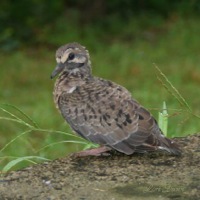Difference between revisions of "Fledgling"
m (moved Fledglings to Fledgling) |
m (Text replacement - "http://" to "https://") |
||
| (One intermediate revision by the same user not shown) | |||
| Line 2: | Line 2: | ||
==Origin== | ==Origin== | ||
| − | ''fledge'' capable of flying, from [ | + | ''fledge'' capable of flying, from [https://nordan.daynal.org/wiki/index.php?title=English#ca._1100-1500_.09THE_MIDDLE_ENGLISH_PERIOD Middle English] ''flegge'', from [https://nordan.daynal.org/wiki/index.php?title=English#ca._600-1100.09THE_OLD_ENGLISH.2C_OR_ANGLO-SAXON_PERIOD Old English] -''flycge''; akin to Old High German ''flucki'' capable of flying, Old English ''flēogan'' to fly |
| − | *[ | + | *[https://en.wikipedia.org/wiki/16th_century 1566] |
==Definition== | ==Definition== | ||
*1: to acquire the feathers [[necessary]] for flight or independent [[activity]]; also : to leave the nest after acquiring such feathers | *1: to acquire the feathers [[necessary]] for flight or independent [[activity]]; also : to leave the nest after acquiring such feathers | ||
| Line 9: | Line 9: | ||
'''Fledge''' is the [[stage]] in a young bird's life when the feathers and wing muscles are sufficiently developed for flight. It also [[describes]] the [[act]] of a chick's [[parents]] raising it to a fully grown state. A young bird that has recently fledged but is still dependent upon [[parental]] [[care]] and feeding is called a '''fledgling'''. | '''Fledge''' is the [[stage]] in a young bird's life when the feathers and wing muscles are sufficiently developed for flight. It also [[describes]] the [[act]] of a chick's [[parents]] raising it to a fully grown state. A young bird that has recently fledged but is still dependent upon [[parental]] [[care]] and feeding is called a '''fledgling'''. | ||
| − | In [ | + | In [https://en.wikipedia.org/wiki/Ornithology ornithology], the [[meaning]] of fledging varies, depending on [[species]]. Birds are sometimes considered fledged once they leave the [https://en.wikipedia.org/wiki/Bird_nest nest], even if they still cannot fly. Some [[definitions]] of fledge take it to mean the [[independence]] of the chick from the adults. Adults will often continue to feed the chick after it has left the nest and is able to fly. |
| − | One notable [[species]], the [ | + | One notable [[species]], the [https://en.wikipedia.org/wiki/Ancient_Murrelet Ancient Murrelet], fledges two days after hatching, running from its burrow to the [[ocean]] and its calling [[parents]]. Once it reaches the ocean, its parents care for it for several weeks. Other [[species]], such as [https://en.wikipedia.org/wiki/Guillemot guillemots] and some [https://en.wikipedia.org/wiki/Cormorant cormorants], leave the nesting site while they are still unable, or barely able, to fly. The fledging [[behaviour]] of the guillemot is [[spectacular]]; the adult will lead the chick through the colony if possible, for large drops like cliffs, it will fly down and call to its young. The chick will then launch itself off the cliff, attempting to fly as far as possible, crash landing on the ground below before continuing its run towards the [[ocean]]. |
[[Category: General Reference]] | [[Category: General Reference]] | ||
Latest revision as of 00:16, 13 December 2020
Origin
fledge capable of flying, from Middle English flegge, from Old English -flycge; akin to Old High German flucki capable of flying, Old English flēogan to fly
Definition
- 1: to acquire the feathers necessary for flight or independent activity; also : to leave the nest after acquiring such feathers
Description
Fledge is the stage in a young bird's life when the feathers and wing muscles are sufficiently developed for flight. It also describes the act of a chick's parents raising it to a fully grown state. A young bird that has recently fledged but is still dependent upon parental care and feeding is called a fledgling.
In ornithology, the meaning of fledging varies, depending on species. Birds are sometimes considered fledged once they leave the nest, even if they still cannot fly. Some definitions of fledge take it to mean the independence of the chick from the adults. Adults will often continue to feed the chick after it has left the nest and is able to fly.
One notable species, the Ancient Murrelet, fledges two days after hatching, running from its burrow to the ocean and its calling parents. Once it reaches the ocean, its parents care for it for several weeks. Other species, such as guillemots and some cormorants, leave the nesting site while they are still unable, or barely able, to fly. The fledging behaviour of the guillemot is spectacular; the adult will lead the chick through the colony if possible, for large drops like cliffs, it will fly down and call to its young. The chick will then launch itself off the cliff, attempting to fly as far as possible, crash landing on the ground below before continuing its run towards the ocean.
